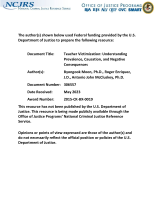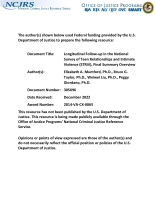Sexual harassment
A Study of the Criminal Victimization of Policewomen by Other Police Officers
Understanding the Impact of COVID-19 on Victim Services
The COVID-19 pandemic had a detrimental impact on communities across the nation and significantly affected various aspects of individuals’ lives. One of the negative impacts was an increase in gender-based violence accompanied by shifting barriers to accessing services and support. Victims and victim service providers faced various challenges dealing with the increase in need for services, navigating barriers to help-seeking, and addressing logistical issues.
See the YouTube Terms of Service and Google Privacy Policy
Victimized Teachers’ Perceptions of Procedural Justice and the Impact on Satisfaction with School Responses
Law Enforcement Officers Safety and Wellness: A Multi-Level Study (2024)
Prevalence of online sexual offenses against children in the US
Military Sexual Trauma Experiences of Female Veterans in Michigan
Inclusive Research: Engaging People Closest to the Issue Makes for Better Science & Greater Impact; 2023 NIJ Research Conference Plenary
This panel will discuss what inclusive research is, how to conduct it, and what issues and challenges exist about engaging in it. “Inclusive research” has its history as a participatory research method designed to ensure people closest to the issue or problem under study are authentically engaged in the research process rather than simply being “research subjects.” While community-based participatory research has begun to take on greater prominence in the criminal justice realm, such efforts are largely confined to qualitative research inquiries.
See the YouTube Terms of Service and Google Privacy Policy
Teacher Victimization: Understanding Prevalence, Causation, and Negative Consequences
Campus Sexual Assault Responses (CSAR): Informing Trauma-Informed Policies, Protocols, and Training
Sexual violence is a significant criminal justice problem with long-term effects for its victims. In particular, sexual assault on or related to college campuses across the United States presents a growing public health and economic burden, starting with significant impacts on academic outcomes.
See the YouTube Terms of Service and Google Privacy Policy
Longitudinal Follow-up in the National Survey of Teen Relationships and Intimate Violence (STRiV), Final Summary Overview
Young Men's Attitudes and Neighborhood Risk Factors for Sexual Harassment Perpetration in the United States
Profiles of Adolescent Relationship Abuse and Sexual Harassment: a Latent Class Analysis
The Rolling Hotspot? Perceptions of Behavioral Problems on School Buses Among a Nationally Representative Sample of Transportation Officials
An exploratory study of violence and aggression against teachers in middle and high schools: Prevalence, predictors, and negative consequences
Longitudinal Follow-up in the National Survey of Teen Relationships and Intimate Violence (STRiV)
Sexual Harassment of Law Enforcement Officers: Findings From a Nationally Representative Survey
Profiles of Youth In-Person and Online Sexual Harassment Victimization
Longitudinal Effects of Gendered Harassment Perpetration and Victimization on Mental Health Outcomes in Adolescence
School Climate Moderates the Association Between Sexual Harassment and Student Well-Being
Associations of Bullying and Sexual Harassment With Student Well-Being Indicators
School Safety: A Focus on Teachers and Administrators - Breakout Session, NIJ Virtual Conference on School Safety
On February 16-18, 2021, the National Institute of Justice hosted the Virtual Conference on School Safety: Bridging Research to Practice to Safeguard Our Schools. This video includes the following presentations:
See the YouTube Terms of Service and Google Privacy Policy





